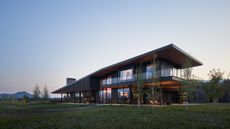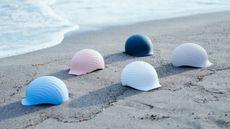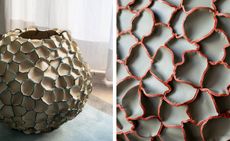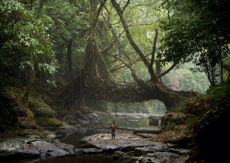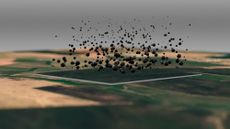Cooking Sections champions regenerative eating at the Serpentine’s The Magazine restaurant
London-based artist duo Cooking Sections has created a menu of three dishes for The Magazine restaurant at Serpentine North, as part of the museum’s ‘Back to Earth’ programme featuring artistic responses to the climate emergency
- (opens in new tab)
- (opens in new tab)
- (opens in new tab)
- Sign up to our newsletter Newsletter

Inside the Zaha Hadid-designed Magazine restaurant at Serpentine Galleries, a climate solution is cooking. In the face of a global food crisis, a complex set of problems around how we consume food requires an equally involved set of solutions. Daniel Fernández Pascual and Alon Schwabe, founders of London-based studio Cooking Sections, are working across disciplines with scientists, chefs, and policymakers on their ongoing research project, Climavore. As part of ‘Back to Earth’, the Serpentine's long-term programme featuring artistic responses to the climate emergency, Cooking Sections has created a menu of three dishes: one small, one large, and one sweet. Each aims to showcase an adaptive and ecologically conscious food system.
What began in 2015 to encourage restaurants across the United Kingdom to replace farmed salmon from their menus with more sustainable ingredients (by way of stimulating marine habitats and improving water quality) has become a much larger conversation. Through collaborations with Cooking Sections, cultural institutions in the UK, Sweden, and the United States are addressing the issue of food industrialisation. ‘It's about setting the framework under which chefs, cooks, anyone, can develop to their own needs and scale,’ says Schwabe. ‘We're not writing recipes and distributing them to restaurants. These recipes are made by the chefs.’

Cooking Sections’ Climavore: On Tidal Zones, 2017 on Isle of Skye, Scotland.
The three new dishes for The Magazine are made with regenerative agriculture in mind. Using plants designed to improve the quality of their soil (a rotational crop practice rooted in Indigenous wisdom), tomatoes on toast is served on YQ sourdough – the name stands for ‘yield/quantity’, an alternative flour with a unique flavour profile. This approach strives to introduce renewed grain varieties at optimal times of the year. ‘When you go to the supermarket in cities like London, you can find pretty much anything all year round; there's a certain erosion of the seasons,’ says Fernández Pascual. ‘So we started to consider how seasons can inform choices, but also policies or landscapes.’
When we regard market stalls during the seasons: spring, summer, autumn, and winter, we're met with artichokes, blackberries, pumpkins, and clementines. But looking to the future, with the trajectory we're on, what would it look like to eat in the season of polluted oceans and drought or the season of wildfires and flash floods? This is the exact thought experiment that launched Climavore. ‘We thought it would be compelling to work with a restaurant to do an intervention there. For us, the restaurant is a significant place,’ says Fernández Pascual, who points out that the term ‘restaurant’ can be traced back to the 19th century, and derives from the French restaurer. ‘We like to see the restaurant as a place, not only to restore the human body but to restore ecology at large today.’

Cooking Sections’ Climavore: Seasons Made to Drift, 2021, at Salt Beyoglu, Istanbul.
The Magazine is an extension of Serpentine North, which was built in 1805 as a gunpowder store. Hadid’s glass walls curve in space around oval skylights in the deep billowed ceiling, creating a characteristically organic form. The gallery's gardens can be seen past sculptural columns that punctuate the dining room. As the Serpentine’s leading food and drink destination, The Magazine is an extension of its exhibitions. After tomatoes on toast, the ‘Back to Earth’ menu offers British chickpea tabbouleh with bright summer squash, lemon verbena harissa, robust barrel-aged feta and mint. Then to finish, a seasonal rhubarb and British red and white quinoa cake, served with bay leaf honey and stem ginger ice cream. A simple menu infused with elaborate research.
Through Climavore, Cooking Sections offers actionable sustainability through collective transformation. Any one of the ‘Back to Earth’ dishes is a feast for the palate, but more importantly, it opens a dialogue. It encourages us to participate in the discussion and include all voices in developing new strategies and innovations to better the future of food.

Our artist's palate feature in the August 2022 issue features the recipe for Cooking Sections’ tomatoes on toast, (pictured with a Seaweed Seeper), which is served at The Magazine alongside chickpea tabbouleh, and rhubarb and quinoa cake.
INFORMATION
serpentinegalleries.org (opens in new tab); cooking-sections.com (opens in new tab)
-
 Sapir Bachar’s love for silver makes for abstract jewellery forms
Sapir Bachar’s love for silver makes for abstract jewellery formsSapir Bachar’s fashion background informs her eponymous jewellery brand
By Pei-Ru Keh • Published
-
 Spectacular Wyoming ranch sits within a restored working landscape
Spectacular Wyoming ranch sits within a restored working landscapeThis Wyoming ranch by CLB Architects offers a new approach to the Western architectural tradition, combining daring and functional modern design with a welcoming character
By Jonathan Bell • Published
-
 Last chance to see: Cyprien Gaillard on chaos, reorder and excavating a Paris in flux
Last chance to see: Cyprien Gaillard on chaos, reorder and excavating a Paris in fluxWe interviewed French artist Cyprien Gaillard ahead of his major two-part show, ‘Humpty \ Dumpty’ at Palais de Tokyo and Lafayette Anticipations (until 8 January 2023). Through abandoned clocks, love locks and asbestos, he dissects the human obsession with structural restoration
By Harriet Lloyd-Smith • Published
-
 Shellmet: the helmet made from waste scallop shells
Shellmet: the helmet made from waste scallop shellsShellmet is a new helmet design by TBWA\Hakuhodo’s creative team and Osaka-based Koushi Chemical Industry Co, made using Hokkaido’s discarded scallop shells
By Jens H Jensen • Published
-
 Wentz presents innovative furniture incorporating ocean plastic waste
Wentz presents innovative furniture incorporating ocean plastic wasteThe ‘Mar’ collection by Guilherme Wentz is informed by the sea and features computerised 3D-weaving techniques to transform ocean-borne plastic
By Scott Mitchem • Published
-
 Liaigre ‘Upcrafted’ objects showcase potential of sustainable design
Liaigre ‘Upcrafted’ objects showcase potential of sustainable designStriding confidently towards more sustainable production, interior design company Liaigre has released ‘Upcrafted’, a series of limited-edition objects for the home, assembled attentively from the studio’s would-be waste
By Martha Elliott • Last updated
-
 Regenerative design: meet the creatives taking a rooting interest in learning from nature
Regenerative design: meet the creatives taking a rooting interest in learning from natureRegenerative design: meet the creatives taking a rooting interest in learning from nature
By Malaika Byng • Last updated
-
 No time for waste: Oris’ collaboration with a leather manufacturer recycles deer skins
No time for waste: Oris’ collaboration with a leather manufacturer recycles deer skinsDeer skins make for sustainable watch straps in a partnership between Oris and Cervo Volante
By Hannah Silver • Last updated
-
 Best recycled designs from the Wallpaper* Design Awards
Best recycled designs from the Wallpaper* Design AwardsContemporary designers are using waste to create furniture designs that combine a distinctive aesthetic with a sustainable approach
By Anne Soward • Last updated
-
 Terra Carta Design Lab announces finalists
Terra Carta Design Lab announces finalistsHRH Prince Charles and Jony Ive, in collaboration with the Royal College of Art, announce the 20 finalists of the Terra Carta Design Lab
By Rosa Bertoli • Last updated
-
 Jony Ive’s LoveFrom unveils Terra Carta Seal design
Jony Ive’s LoveFrom unveils Terra Carta Seal designDesigned by Jony Ive to celebrate nature, with an intricate composition of flora and fauna, the Terra Carta Seal represents the charter’s values and will be bestowed upon private sector companies that distinguish themselves for their sustainability efforts
By Sarah Douglas • Last updated

